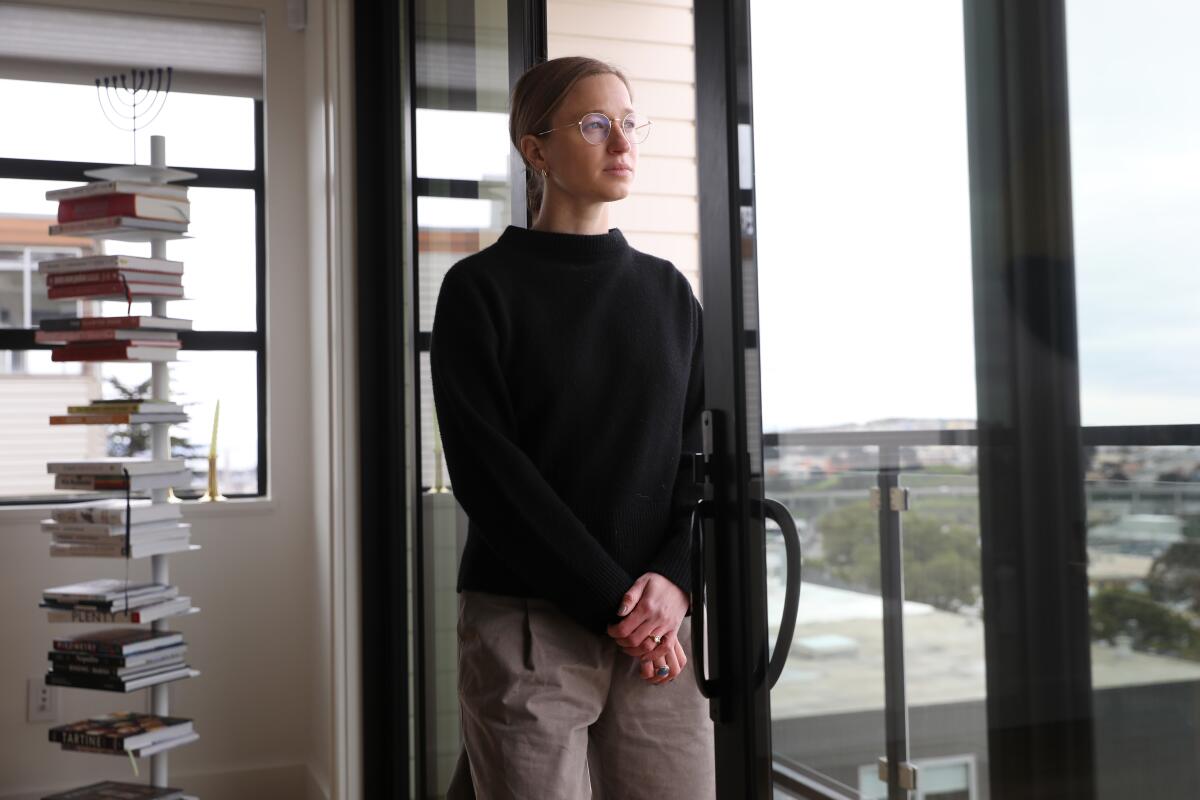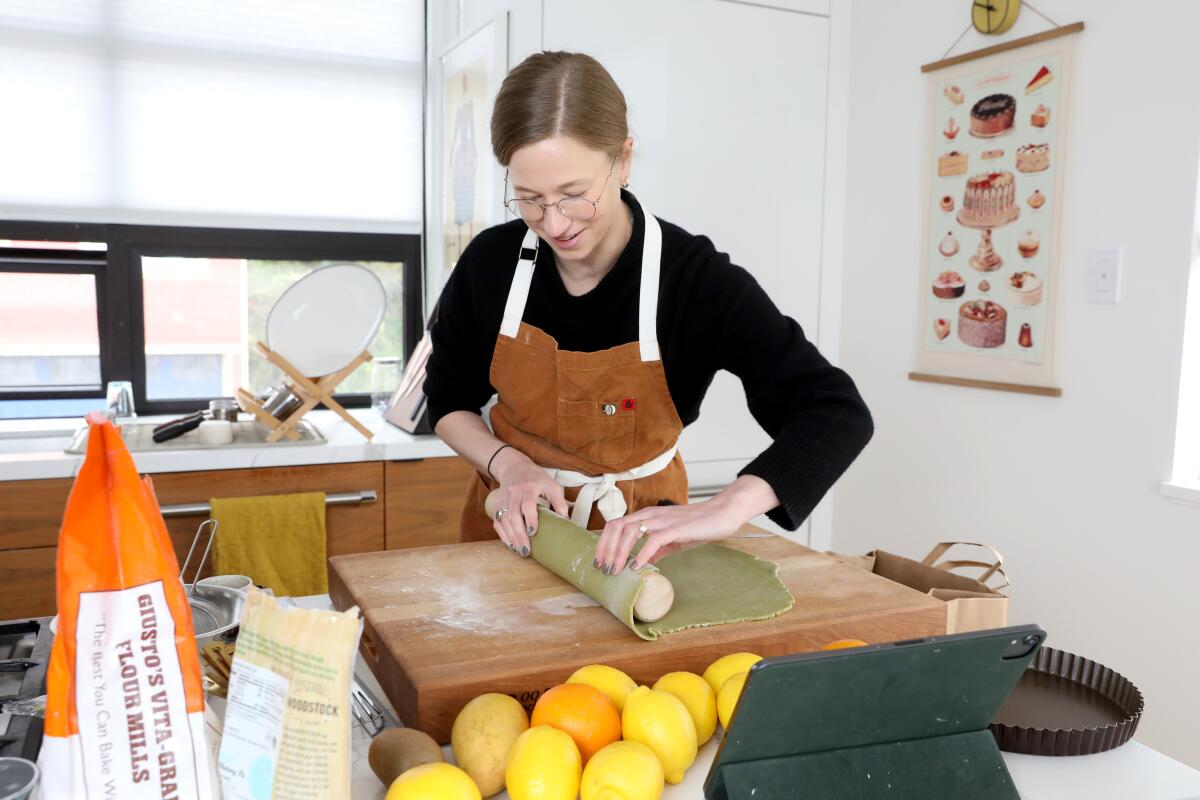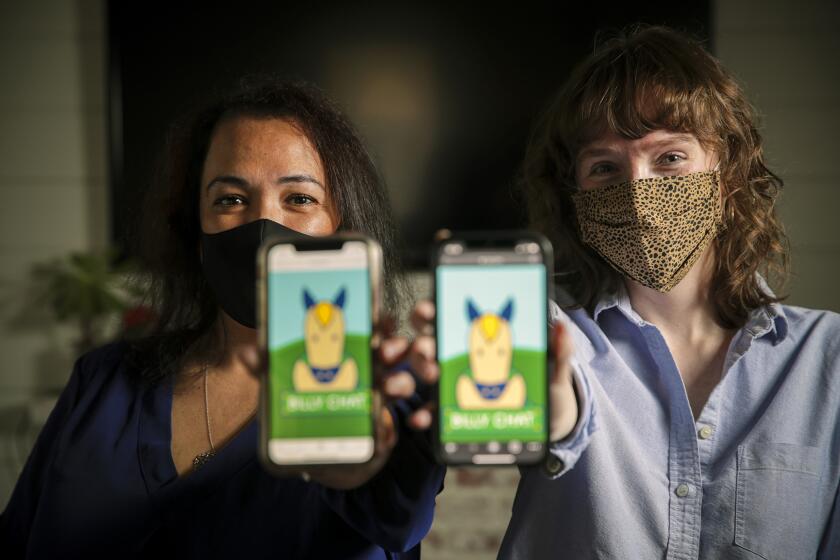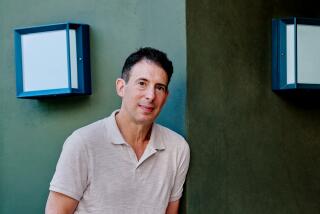They were battling the psychological toll of the pandemic. Their therapist was, too

- Share via
It was almost Shabbat, but Ariel Friedman was too busy to bake challah.
Anxiety among the Bay Area therapist’s clients was spiking. It was mid-March 2020: More than 1,500 Americans had tested positive for the novel coronavirus. Forty-one had died. Friedman’s clients — some with post-traumatic stress, others with obsessive-compulsive disorder or depression — wanted reassurance. But there was none to be given.
Her office staff was on edge, too, as plans were made, then remade. They’d definitely stay open; they might stay open; no, they’d definitely close. Sentiments changed four times that day, sending Friedman chasing clients through the waiting area on their way out with updates. This new scary thing, this mercurial disease with the strange shape and the regal name, was upending everything.
In the days and weeks that followed, many states, including California, imposed stay-at-home orders, which sent an “avalanche of existential trauma” onto the laptop screens of therapists like Friedman, who had suddenly become front-line workers in an intensifying mental health crisis, helping clients battle malaise, isolation and fear during virtual sessions.
For the first time in her career, Friedman, a slight woman who wears round, thin-rimmed gold glasses, wasn’t simply helping clients through grief and anxiety; she was experiencing the same emotions alongside them. What gnawed at them also gnawed at her. She had to do something to cope, a simple act that would turn into a ritual to keep her sane. She needed to make time to bake.

And she did. When it seemed like too many clients were in simultaneous crises, when she couldn’t put work out of her mind, when the pandemic seemed to be coming too close, Friedman began pulling out her rolling pin. There were weeks, she recalls now, when her oven seemed perpetually warm.
::
It all seems so long ago now, those first days when a nation was learning the difference between an epidemic and a pandemic and how a ventilator works and what happens when body bags are in short supply. Vaccines are rolling out and lives are returning to rhythms that once were. The dead still multiply but not like before.
“We see this after war: When the imminent threat dissipates, the survival response lingers,” Friedman said. “If you magnify that by a city, a country, the world — you see that there is indeed a way forward from here — but it’s not around, it’s through.”
Peril entered homes and stayed. It touched everything.
Friedman, 28, who has a master’s degree in counseling psychology from Columbia and is finishing a PhD, had been taught that therapy works, in part, because it is contained in a physical and emotional space separate from the rest of life. For most of her clients, that separate space was gone overnight.
During virtual counseling sessions with Friedman, their toddlers wailed. Family members fought. A partner’s prying ears might be on the other side of a thin door. The internet cut out. Cell service was bad. Clients paced on the sidewalk, hid in their cars, paused to change locations many times in a 50-minute session.
They sometimes appeared more stressed at the end than at the beginning.
“There’s an element of bearing witness to someone else’s pain that involves sharing a deep breath in the same space, just the two of you,” Friedman said. “I could see it in their faces: They couldn’t get to me, couldn’t access that space. No matter what I did, I couldn’t give it to them.”
Suicide prevention and crisis counseling resources
If you or someone you know is struggling with suicidal thoughts, seek help from a professional and call 9-8-8. The United States’ first nationwide three-digit mental health crisis hotline 988 will connect callers with trained mental health counselors. Text “HOME” to 741741 in the U.S. and Canada to reach the Crisis Text Line.
She and her fiance, Robbie Heeger, had their own tensions. They were cramped in a shoebox San Francisco flat. He was recovering from an invasive back surgery and running a nonprofit from the living room, but was relegated out of earshot every time she held a therapy session. Privacy was scant. The pressure built.
They were also experiencing a stress reaction she knew well: oscillating between hypervigilance and denial. It wasn’t clear whether they should sanitize their mail or tease people who did. Her clients, too, each in therapy for different reasons, mirrored her perplexity. The hourly news whiplash was disorienting.
By mid-April, Friedman, who was becoming her own client, a woman on the verge, could hardly fight the irrational urge to board a flight to New York City. Her mom was still commuting to her food manufacturing job in the area and her grandmother was in assisted living. Friedman worried that, if she didn’t fly into the hot zone, she’d never see them alive again.
But Friedman couldn’t legally practice therapy from out of state. It felt like choosing between her clients and her family. Common sense won: She shouldn’t leave.
Instead, she made lemon almond macaroons. Four days later, it was cinnamon raisin bagels. After that, a crumbly citrus tart with grapefruit slices propped across the glaze. And challah.
“I could point to it and say, ‘I put my energy here today, and this is what I created,’” she said. “Something sweet that tastes good — that was like my airplane oxygen mask, to help myself before helping others.”
::
As the days passed, the socioeconomic disparities of the pandemic became ever clearer. Friedman offered low-cost services, which meant many of her clients worked essential jobs that put them in danger. Some quickly lost health insurance and child care. Others lived in food deserts, she said, and had preexisting health conditions more prevalent there.
With old traumas and phobias exacerbated, clients were frayed and teetering on the brink. They asked for extra sessions. Couldn’t relax their shoulders. Told her they wanted to go to sleep and never wake up.
She taught them deescalation skills to draw them back, like splashing their faces with icy water, or closing their eyes to focus on the sensation of the floor beneath their feet. But when they were worried about loved ones — crippled by the “when-am-I-gonna-get-the-phone-call terror,” she admitted to her clients: She was, too.
“Therapists have great practice in compartmentalizing,” she said. “But this was simply what it felt like to be a human. No one was exempt from deeper self-knowledge this year.”
By late May, coronavirus infections in America rose to 1.6 million. Then the video surfaced of George Floyd’s killing, another nerve-fraying moment in a country reeling with trauma. The early-pandemic facade that “we’re all in this together,” she said, had collapsed.
Friedman, who is white, worried that her presence would feel unsafe to clients of color. A nation’s shameful legacy was colliding with its newest danger.
The coronavirus death toll in the U.S. topped 100,000.
She fretted. She stewed. She warmed the oven and baked.
::
By autumn, it seemed like everyone was seeking therapy. Depressed people grew more depressed. Eating disorder survivors relapsed. People long-recovered from substance abuse were sitting at home with little else to crave.
Friends who had scoffed at her line of work — deeming it self-indulgent — asked for referrals. Friedman’s caseload nearly tripled, and she was now working with children as young as 6.
The kids were like sponges, absorbing their parents’ and teachers’ stress until the burden was too weighty for play. They weren’t creative or silly. They drew pictures of lonely cats. An 8-year-old who hadn’t seen his friends in six months had concluded he simply didn’t have any.
During sessions, Friedman tried to create a context that mimicked recess or school bus rides: places to take safe risks and process disappointments that are vital to developing personal identity.
Still, the 18-inch window into their lives had its constraints. She couldn’t tell when their breathing changed. There was no eye contact to be broken. Friedman couldn’t subtly check arms and legs for signs of self-injury or abuse, or sense the distinct energy in a room when a child was keeping a secret.
She learned to ask more direct questions of young clients. But their parents often lingering a few feet away, children could be reluctant. Friedman felt powerless; as if she and her clients were trapped in separate vacuums.
There’s an element of bearing witness to someone else’s pain that involves sharing a deep breath in the same space, just the two of you
— Ariel Friedman
She and Heeger moved into a bigger apartment with office spaces for each of them. The kitchen was brighter, with better baking ambiance. To get time alone, she walked — first a mile, then two, then eight. The New Yorker in her couldn’t believe she was walking for leisure, and the therapist in her reminded that there was a difference between healthy exercise and scrambling for control.
They were all elements of grief: denial, resistance, bargaining.
“I could keep adding distance,” she said, “but 10 miles a day wouldn’t make the pandemic stop.”
Then wildfire season arrived. The air filled with smoke as the Northern California skies burned orange. Windows were latched shut.
Trapped inside, Friedman’s losses — all that she had missed — began to engulf her. Shopping for a wedding dress with her mother. The births of two cousins. Several friends’ weddings. The chance to travel to Washington to present her research. A long-planned 60th birthday trip for her father to see the 2020 Olympics in Japan.
She wouldn’t be observing the Jewish holidays in a synagogue. And for the first time ever, she wasn’t traveling East for the holidays.
Cal State campuses began using ‘chatbots’ to keep more students enrolled, but after the coronavirus hit, the bots became sources of solace and friendship.
Friedman developed what she calls “compassion fatigue” — an empty tank, but an engine that won’t stop revving. She was in a fog for therapy sessions during the day but couldn’t put away her work at night. She felt as if her life had become a string of browser tabs: client notes, takeout orders, doomscroll binges.
Friedman felt disembodied, out of touch with her physical space.
With Heeger’s encouragement, she shuffled to the kitchen and made chocolate-raspberry-apricot rugelach, posting a snapshot to her Instagram page with the username “@Tart_Therapy.” Then, for Rosh Hashana in September, she made a round cinnamon raisin challah for just the two of them. For Hanukkah: jelly doughnuts. In late December: batches of holiday cookies that looked like they belonged in a French patisserie. She curated bundles of the sweets and delivered them to nearby friends.
Friedman, who doesn’t believe in therapists self-disclosing, never told her clients about her obsession. But when she noticed some step-by-step, sensorial equivalent in a client’s life — like backyard gardening, or tabletop puzzles — she urged them to indulge.
Last month, after years of chronic back pain and 12 months of frustratingly slow healing, Heeger’s steadfast rehab paid off. The last of his doctor’s activity restrictions have been lifted.

Friedman these days keeps busy with egg beaters and mixing bowls. Her recipes have evolved into kaleidoscopes of rosemary, matcha and orange cranberry curd. The purpose of therapy, she says, isn’t to rid of life’s uncertainties, but to learn to embrace what we cannot control.
But some things we can. She chooses the oven’s temperature, measures sugar with precision. She ignores her iPhone’s breaking news pings. Her fingers are too sticky with dough.
More to Read
Sign up for Essential California
The most important California stories and recommendations in your inbox every morning.
You may occasionally receive promotional content from the Los Angeles Times.










